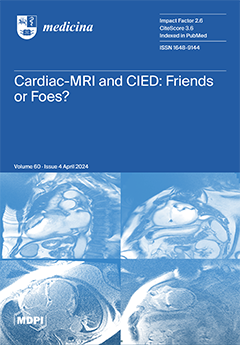Background and Objectives: In this study, we aimed to evaluate the effects of six weeks of pulmonary rehabilitation on functional and psychological outcomes in long-COVID patients.
Material and Methods: The prospective clinical study included 46 patients that were diagnosed with COVID-19. A respiratory rehabilitation program was implemented for six weeks. Further valuables were tested before the beginning of the rehabilitation program (admission) and six weeks after (discharge): SpO
2, heart rate, respiratory rate, Visual Analogue Scale (VAS) score, Borg score, Sit-to-Stand (StS) test number of repetition, distance of 6-Minute Walking Test (6MWT), Patient Health Questionnaire (PHQ) 9 score and Generalized anxiety disorder (GAD) anxiety score. These parameters were tested before the rehabilitation program on admission and at discharge and after the rehabilitation program on admission and at discharge. The results were presented with standard descriptive and analytical methods. Differences between the continuous variables before and after physical rehabilitation intervention were tested using the Wilcoxon test. Graphical analysis is presented with a box plot.
Results: On discharge, in comparison with admission, the values of SpO
2 were significantly lower (
p = 0.007) before the 6MWT, and VAS scores were significantly higher (
p = 0.036), while after the 6MWT, VAS scores were significantly lower (
p < 0.001) as were Borg scores (
p = 0.016). On discharge, in comparison with admission, the respiratory rate was significantly higher (
p = 0.005) before the StS test, and Borg scores were significantly lower (
p = 0.001), while after the StS test, SpO
2 levels were significantly higher (
p = 0.036) and VAS scores were significantly lower (
p < 0.001), as were Borg scores (
p = 0.008). After discharge, the values of the StS test were significantly higher (
p = 0.011), PHQ9 scores were significantly lower (
p < 0.001) and GAD anxiety scores were significantly lower as well (
p = 0.005), while the distances measured in meters on the 6MWT were significantly increased (
p < 0.001).
Conclusions: A structured rehabilitation program in our study was shown to have beneficial effects on physiological, psychological and functional improvements in patients with long-COVID, and therefore it is advisable for these patients.
Full article






